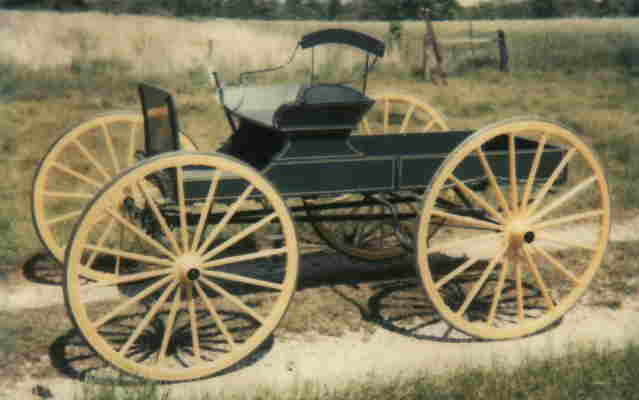|
|
 |
|
BUGGIES
|
 |
I have always been fascinated by the grace of horse carraiges and large skinny wheels, and when in 1980 the under
pinnings and wheels of a buggy appeared in a neighbor's yard sale, I jumped on it, subsequently creating the body of
the vehicle shown above. Suspension is by a pair of side springs, running front to rear. We bought a driving
horse next, and did several parades with the outfit. This buggy remains in my collection, ready to hitch up. Got
horse?
 The irons for this sleigh came with enough rotted wood to enable me to construct this Cutter body, which was
a delight on snow and ice, behind the driving horse. Its a cold experience in winter, but the sound of runners on different
road surfaces in otherwise silent surroundings, was right out of Currier and Ives. Not something experienced often.
A driving horse is a lot of work to use and keep, but this sleigh, of all vehicles, made the bother of the horse almost
worthwhile. We did finally dismiss the horse, the vehicles being considered far more interesting and less costly.
 This Spring Wagon was another case of building a wood structure to suit the original running gear, following what little
remained of the old wood. New wheels came from the Amish wheel factory in Holmes County, making this a terrific
modern wagon. Two seats, both removable (shown with just one), tail gate at the rear like a pick-up, it was suitable
for actual every-day use. This wagon could take the family to church meeting or run to the feed
store.
Speaking of Currier and Ives, this Racing Sulky is right out of another print. Excellent original condition, it
would have been used during the 1800's to show off a high stepping thoroughbred, ripping up country lanes, impressing the
ladies. All I had to do was give it a satin yellow finnish and pin stripes.
This is called a Chair, a 17th century form. Using new wheels, irons and wood, I copied from photos and
museum plans, gathered material and parts for two vehicles, but assembled and sold just this one. The parts for
the second Chair are still in the barn, less wheels, along with other miscellaneous unfinnished vehicles and projects.
I may get around to finishing them yet.
I built the Hitch Wagon on the running gear of a turn-of-the-century milk wagon, using new Amish-built
wheels, and all new wood for the box and seat. It was sold August 7, 1982, at the Wheat Ridge Amish consignment auction
(Adams County). I had been driving the Amish buggy man to Holmes County procuring parts and materials for both of us,
for a couple years. We made trips to Pennsylvania also, to buy and sell horse vehicles. We enjoyed a mutually
beneficial arrangement of travel and horse vehicle expertise. A wonderful experience for me.
This Side Spring Wagon is in as-found condition, solid except for a poor leather seat back. It was not
an economy model when new. With graceful curved bed, it had two removable seats (one now missing), and a very
small rudimentary tail gate, only 5 inches high. It seems hardly worth constructing so small a feature.
This wagon remains in my collection.
This Cut Under carriage was the fanciest to pass through my hands. The name describes the front wheel ability to
pass under most of the body when turning sharply. This was desirable for maneuvering in close quarters, as in town
traffic. There were two doors, one missing which I created, each only 7" by 15" or so. The rest
of the body wood was in decent original condition. The folding top is a 'Gypsy" top.
The Coal Box buggy name comes from the shape of the rear of the body, being curved to resemble a coal scuttle, unfamiliar
to most of us now. The shape does not show well here. A relatively rarely seen vehicle today, it carried
only two people, tightly.
1888 Side Bar buggy by Stivers-Tilton, New York. The rubber balloon tires were probably a later retrofit, inspired
by turn-of-the-century automobile development. The tires still inflate, but don't hold air for long.
Suspension was only from the
resiliency of the hickory side bars, hence the name. This buggy will remain in my collection.
The large Jolt Wagon is typical of farm wagons built in the 1800's, commonly hitched to one or two pairs of draft horses.
This wagon has extra side board extensions to increase bed capacity. It is in wonderfull original condition, ready
for parade duty. Included but not visible are uncommon patent spring units between bed and bolsters to cushion
the ride somewhat, but it is still a 'jolt' wagon. Seat bottom is 6 feet from the ground. This wagon stays in
the collection.
The Bob Sled has original bobs (runners), and a new box bed, nine feet long. Seat is removable, this was a utilitarian
farm vehicle, a single or pair of light horse would have been strong enough to pull it on snow and frozen ground. This
vehicle is safe in the collection.
This One Horse Cart, or Sulky, is in excellent original condition, with recent varnish finish. A sulky is
a one person vehicle, used for general transportation behind a light horse. This nice cart with rubber tires remains
in my collection.
|
 |
|
|
 |
|
|
 |
|
|
|
|
|
|
 |

